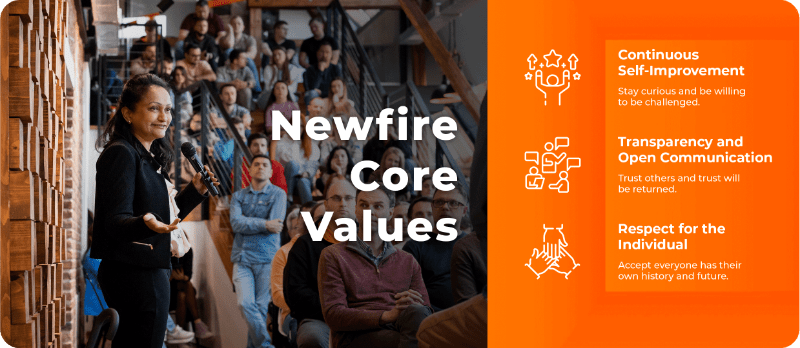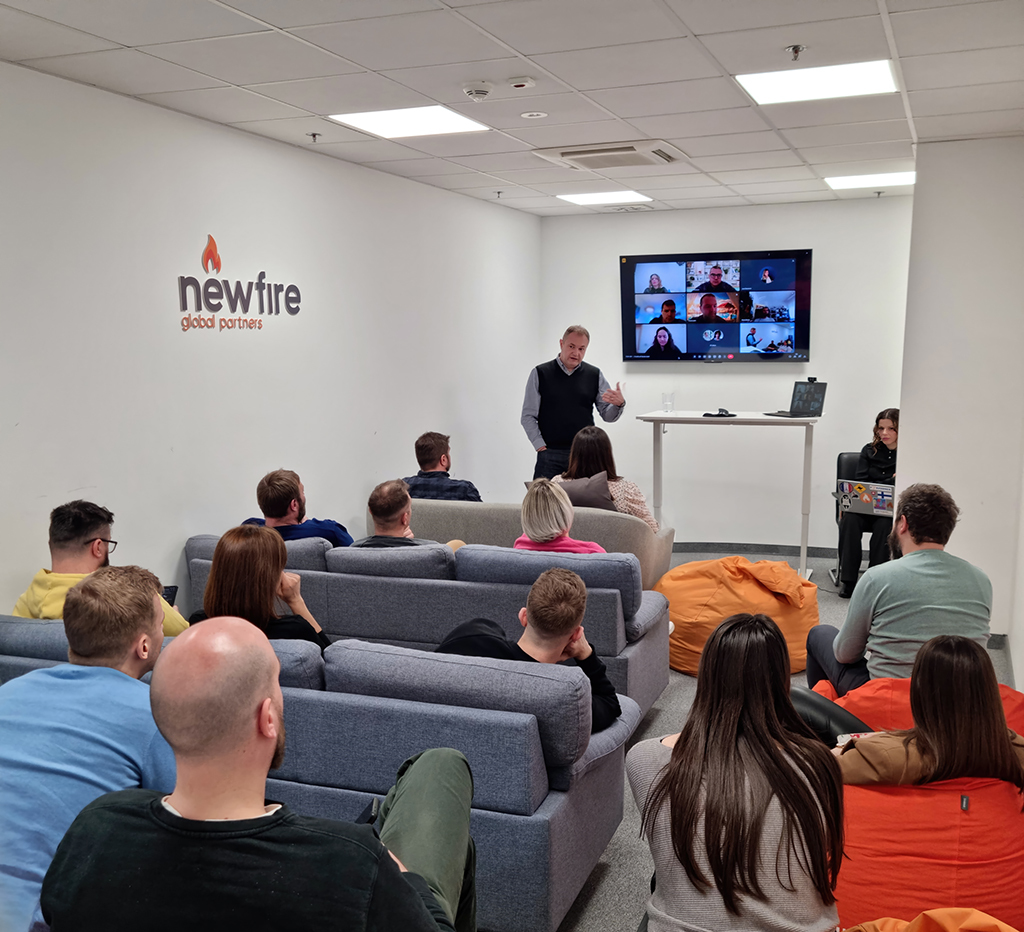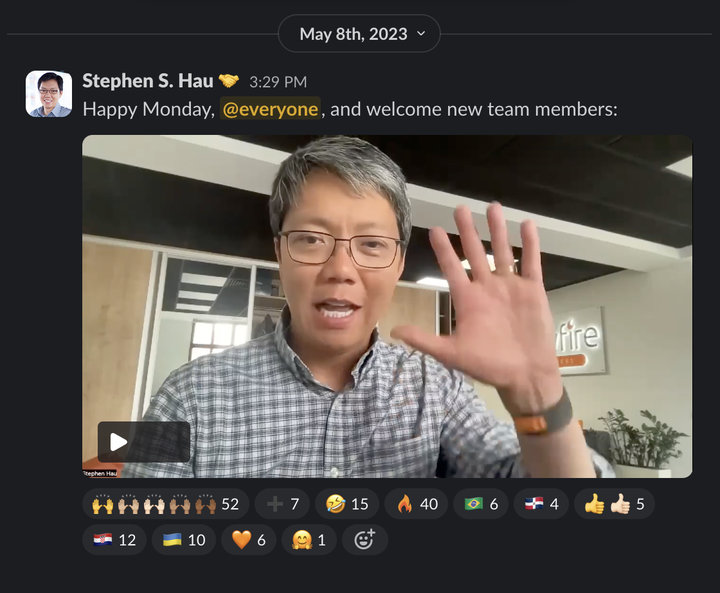Enhancing Project Delivery With Remote-First Culture

When it comes to high-performing teams, should the sum of the parts be greater than the whole?
This article uncovers the link between company culture and effective project delivery. At Newfire, client success is at the core of our efforts to build a close-knit, remote-first culture. Below, you’ll find insights into how we’re achieving this, as well as practical advice for your own cultural strategy.
What Does It Mean to Build a Team?
As a technology and people leader, you may have experienced situations where your rockstar team members are unable to accelerate outcomes and capture the synergies that should come from working in a high-performing team setting. Ever wondered why?
At Newfire, we believe the answer lies somewhere on the collaboration-trust spectrum.
Capability and skills aside, efficient, high-quality project delivery often comes down to people’s ability to collaborate effectively. Over the last few years, we have had to rapidly adapt to remote work. This process has given us plenty of opportunities and a variety of tools to enhance our remote work capabilities, and yet the idea of a T.E.A.M. (where Together Everyone Achieves More) does not always come to fruition.
It really does boil down to first principles: why do some teams work well together? Or an even more basic litmus test question: who would you want on your team? Usually, it’s people you have worked with before, who you know to be dependable, and who you trust to get the work done. In remote-first settings, building this kind of trust can be challenging, but it comes easier with a strong cultural strategy in place.
Culture takes an even more central role in global working environments. A well-understood and practiced culture is a powerful tool for building high-performance teams. That kind of culture fosters higher creativity and better productivity, leading to more effectiveness in solving challenging client needs. A strong culture can help teams move in unison, unlocking innovation and fast progress on goals, even when teammates are thousands of miles apart.
Connecting Company Culture to Project Delivery Excellence
We often underestimate the potential of culture to energize a group, perhaps because it can be challenging to show tangible straight-line impact connecting culture to outcomes. After all, unlike the objective clarity provided by engineering KPIs, culture is a subjective experience, which makes it difficult to measure.
But the reality is that efficient, quality output and even world-changing innovation become possible only through effective ways to interact and work together. Company culture is, at its core, a set of values, norms, and behaviors relating to how we orchestrate the individual instrumentalists on the team into a symphony!
At Newfire, we uphold an adage that we are not just colleagues but a family of professionals. Just as we have a fundamental value system in a family, on which we act and hold each other accountable, so too in a professional setting, we expect this to be an “all of us, all the time” endeavor. It’s about adopting collaborative behaviors that leverage individual strengths to achieve goals.
The central role of company culture in achieving business goals is well documented in research. For example, we can trace the failure of many corporate transformations back to culture and people-related problems. On the flip side, we know that organizations with a robust culture achieve three times higher returns for shareholders.

A culture-building strategy, especially in remote-first environments, requires deliberate, globally consistent habit-creation on an organizational level. In the following section, you’ll find a solid starting point and first steps for your own effort to build a healthy company culture.
Building a Remote-First Culture: Where to Start?
Be Intentional
The pandemic accelerated the shift towards work-from-home policies. We have learned that remote work environments are indeed effective but require conscious efforts to build a culture that will sustain a tight-knit community where coworkers have opportunities to learn about each other.
Whether you’re building a remote-first startup or shifting to a remote style of work in an established organization, one key principle should guide you: successful company cultures arise from individual needs, habits, and values. There are no universal or one-size-fits-all approaches. Therefore, your first step is to find out how your team members tick on a hyper-local level and then use that knowledge to develop a global engagement strategy.
Establish a Set of Norms Locally
Before you do anything else, the best practice is to establish a set of team norms. To do that, have individual teams spend time together, even if that is done virtually. Here are some discussion points I’ve found to be conducive to establishing team norms:
- What does success look like for each of us on this project?
- What are our work styles? How would team members present themselves as “me on a page”? Are we, as individuals, organized or last minute? What are our stressors and motivators?
- What can each of us commit to doing for the team?
- Where are our boundaries, times of the day (or days) when we need to focus on responsibilities outside of work?
- How do we like to be contacted? Which hours, how many touchpoints, and which managerial style suits us best?
- How do we, as a team, plan to resolve conflict?
This process can be awkward, especially for remote team members who are unfamiliar with each other and can’t meet in person, but the end results are well worth it because once you have a set of team norms, you can distill the most important ones into a set of behaviors.
The leader may need to facilitate at first. I often like to have a discussion around a few standard situations and have the team work through the above questions so we can arrive at our team norms as a group. After that, you can assign (and then rotate) a captain role to check in regularly and ensure the team stays true to the established norms.
Formalize Your Company Values
Newfire serves as a great example here. Our team spans four continents and a dozen countries. It consists of senior experts in the fields of engineering, data, product, and business who share a penchant for tech innovation and a desire to put their skills to the test every day. The values we have chosen for ourselves reflect this spirit.

You can formulate your own values in a similar way: find the norms shared by most of your team members (three to five is enough) and think about how you can leverage them to achieve your business goals while giving your teams what they need to work comfortably and productively.
Develop a Global Engagement Strategy as a Catalyst for Cultural Alignment
With your values formalized, your next step is to continuously engage in activities that promote your values and induce behaviors you want to proliferate in your organization. And don’t forget to nurture a remote-first approach by leveraging technology and committing to hosting as many activities online so that everyone can participate.
If you need some inspiration, here is an insight into how we bring culture to life at Newfire through a year-round engagement strategy.
Culture in Action: Examples From Newfire
At Newfire, culture is a verb, not a noun. We achieve this by carefully planning an engagement calendar that instills a better understanding of each other’s backgrounds and our common goals as a company. Here are some examples:
We practice transparency in standard ways, like global quarterly Town Hall meetings and local All Hands meetings, the latter being held in local languages to facilitate two-way communication.

We also organize events and activities spearheaded by our Culture Carriers. This is not some central initiative that someone in management or HR does for you. It’s an open call for anyone who is interested in leading or suggesting activities, and everyone has an opportunity to get involved.
A lot of our culture-building stems from a desire to exchange social and cultural experiences. A great example is the Newfire Cookbook, which features typical recipes from team members’ home countries, and the “Light My Fire” monthly talks series, in which team members share stories from their cultures, personal hobbies, and work projects.
Equally, it’s about turbocharging our learning through various initiatives, such as soft skill workshops and more formal TechTalks by industry experts. For example, Jeff Sutherland, one of the co-creators of Scrum methodology, recently gave a talk in which he shared insights from his new book, First Principles in Scrum, with Newfire’s engineers and product experts.

By establishing team norms and, subsequently, company values and organizing activities around them, you’ll soon create a living, breathing company culture that promotes a sense of community at your organization but also gets business results, thanks to an established way of working together that helps team members achieve common goals, even from opposite sides of the world.
Measuring the Impact of Culture Building in Remote Teams
As important as culture-building is for healthy team functioning and efficient project delivery, its impact is somewhat difficult to measure. The usual HR metrics, such as employee attrition, tenure, and NPS, do apply here; however, you may have to wait to see progress on those KPIs, which may prevent you from making timely improvements to your strategy.
Fortunately, there are some indicators you can use to confirm your efforts are moving in the right direction. While these methods won’t provide you with exact data, they will help you assess if your culture is aligned with your team’s needs and conducive to faster, higher-quality delivery.
One of them simply involves tracking employee interactions on internal channels, such as Slack or Microsoft Teams. Are team members reacting to engagement communications? Are they participating in discussions or raising hands to be a part of activities you have planned out? If the answer is yes, and the number of those interactions is growing steadily, you’re on the right track.

Even if you begin your culture-building efforts centrally, with company leadership and the HR department at the helm, paying attention to participation is key.
Do you see new people getting involved over time? Are team members volunteering to organize events and take on an active role in your engagement strategies? This is a clear signal that your culture is becoming entrenched and that there is a growing sense of community at your company. Progress on delivery velocity and quality should follow soon after.
To sum up, culture is abstract and difficult to measure. But there are indicators that can tell you if you’re on the right track: just pay attention to the levels of participation in engagement efforts and wait for the moment culture starts growing from the ground up.
Newfire’s Cultural Blueprint: Enhancing Customer-Centric Delivery Through Team Synergy
At Newfire, our culture-building efforts are focused on delivering innovative, dependable solutions at high velocity for our clients. What sets us apart in the digital health space is a deep awareness that this goal can only be achieved in a working environment where people continuously grow their skills and have a desire to stay and contribute their best work.
I’m proud to report that our efforts have been successful thus far, as evident from our business KPIs. This includes our client NPS, which surpassed 70 in 2023, putting us in the top performance quartile in the IT services industry. Moreover, our average client relationship lasts more than three years, with some ongoing partnerships exceeding six years, meaning customers can expect incoming team members to stay with them for the long haul.
If you’re interested in starting a tech partnership with a company that leverages deep healthcare expertise and a strong, global community of engineers, designers, and product experts, I wholeheartedly recommend a collaboration with Newfire.
Sonali Damle is the Chief People and Transformation Officer at Newfire Global Partners, leading initiatives in change management and transformation. With expertise in leadership development and talent acquisition, she has driven growth in various organizations. Sonali also serves as a Strategic Advisor at Innovaccer and is a member of the Forbes Human Resources Council.
